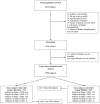Epidemiology and risk factors of chronic kidney disease in India - results from the SEEK (Screening and Early Evaluation of Kidney Disease) study
- PMID: 23714169
- PMCID: PMC3848478
- DOI: 10.1186/1471-2369-14-114
Epidemiology and risk factors of chronic kidney disease in India - results from the SEEK (Screening and Early Evaluation of Kidney Disease) study
Abstract
Background: There is a rising incidence of chronic kidney disease that is likely to pose major problems for both healthcare and the economy in future years. In India, it has been recently estimated that the age-adjusted incidence rate of ESRD to be 229 per million population (pmp), and >100,000 new patients enter renal replacement programs annually.
Methods: We cross-sectionally screened 6120 Indian subjects from 13 academic and private medical centers all over India. We obtained personal and medical history data through a specifically designed questionnaire. Blood and urine samples were collected.
Results: The total cohort included in this analysis is 5588 subjects. The mean ± SD age of all participants was 45.22 ± 15.2 years (range 18-98 years) and 55.1% of them were males and 44.9% were females. The overall prevalence of CKD in the SEEK-India cohort was 17.2% with a mean eGFR of 84.27 ± 76.46 versus 116.94 ± 44.65 mL/min/1.73 m2 in non-CKD group while 79.5% in the CKD group had proteinuria. Prevalence of CKD stages 1, 2, 3, 4 and 5 was 7%, 4.3%, 4.3%, 0.8% and 0.8%, respectively.
Conclusion: The prevalence of CKD was observed to be 17.2% with ~6% have CKD stage 3 or worse. CKD risk factors were similar to those reported in earlier studies.It should be stressed to all primary care physicians taking care of hypertensive and diabetic patients to screen for early kidney damage. Early intervention may retard the progression of kidney disease. Planning for the preventive health policies and allocation of more resources for the treatment of CKD/ESRD patients are imperative in India.
Figures





References
Publication types
MeSH terms
LinkOut - more resources
Full Text Sources
Other Literature Sources
Medical
Research Materials
Miscellaneous

